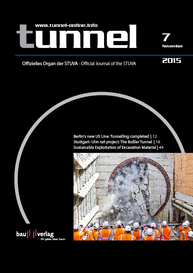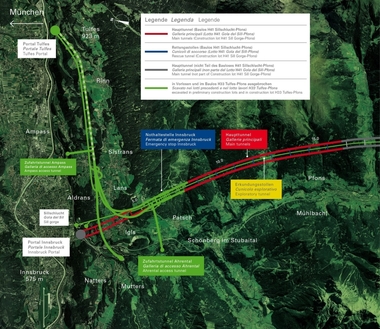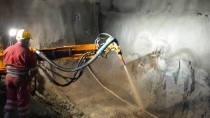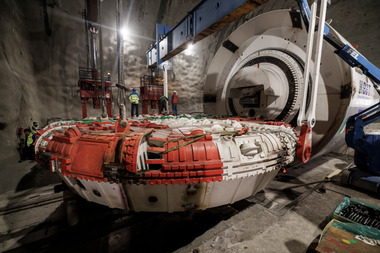Start-Up of the first TBM in the Austrian Part of the BBT
On September 26, 2015, almost exactly a year after works started on the Tulfes–Pfons construction lot, the first tunnel boring machine (TBM) to be used in the Austrian part of the Brenner Base Tunnel began its work and is now making its way through the rock towards Brenner – three months after the first of 75 heavy transports delivered the first part of the machine to the site in Ahrental.
It is an open mode Gripper TBM built by Herrenknecht in Schwanau, Germany, with a 200 m back-up. The TBM was transported to the site in Ahrental in 76 separate pieces, the heaviest of which weighed 120 t. The entire front part was assembled 3.5 km below the surface, inside the mountain itself, in the assembly chamber measuring 120 x 15 x 15 m. The back-up parts, on the other hand, were assembled aboveground in the construction area and moved through the Ahrental access tunnel to the head of the machine.
The engineers and workers assembled the 1800 t machine within three months, working day and night. By now the TBM moving southwards to excavate another 15 km of exploratory tunnel. Using conveyor belts, 1000 t of spoil per hour (600 t from the mechanized excavation and 400 t from drill and blast) are carried from the rock faces directly to the disposal site in Ahrental.
Technical data of the TBM
Type: open TBM with grippers
Installed capacity: 5500 kW
Total length of the TBM including backup: 200 m
Total weight of the TBM including backup: 1800 t
Diameter of the cutting head: 7930 mm
Weight of the cutting head: 150 t
Number of 19” cutter discs: 38
Number of 19” twin double-cut cutter discs: 4
Number of loading scoops: 6
The Tulfes-Pfons Construction Lot
In June 2014, the Tulfes-Pfons construction lot was awarded to the Strabag/Salini-Impregilo temporary consortium; the values of the contract is about 380 million euros. Excavation works began in September 2014. According to the schedule, by spring of 2019 over 38 km of tunnels will have been excavated and over 5 km of these will already have been completed at the end of September 2015.






